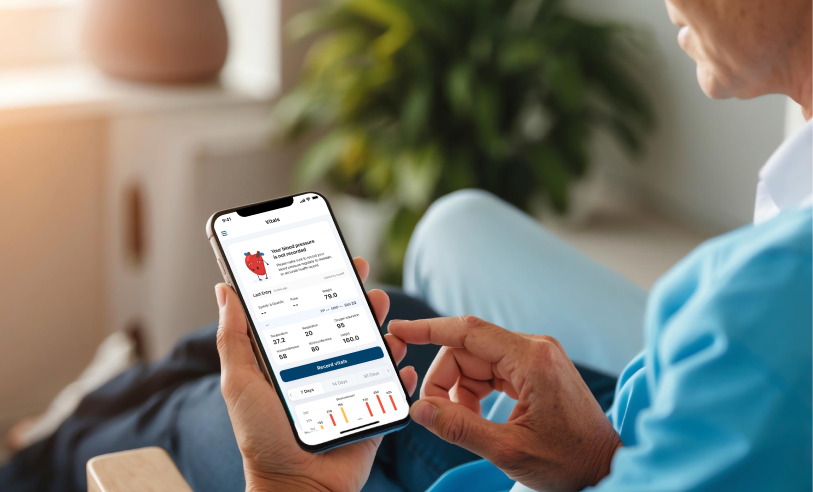Your EHR system should do more than just store data — it should actively reshape the way you deliver care. It should unburden your resources and make collaborative care more effective.
In a world where healthcare providers are overwhelmed by administrative burdens and fragmented systems, blueEHR is designed to unlock efficiency and innovation. This highly adaptable platform not only simplifies workflows but also empowers you to mold your EHR to fit your unique practice needs, making it an essential tool for future-proofing healthcare delivery. Read on to get a detailed grasp of blueEHR, blueBriX’s most coveted digital health solution for value-based care.
The Evolving Challenges in Healthcare Practice Management
Healthcare practice management is a complex and dynamic field that is constantly evolving in response to various challenges. The current healthcare system struggles with issues such as poor integration, slow adoption of technology, and workforce shortages. For instance, estimates suggest that around 98,000 Americans die each year due to medical errors, surpassing deaths from car accidents, breast cancer, or AIDS. Furthermore, 72% of Americans with chronic conditions report difficulties in accessing necessary care.
Additionally, over 57% of U.S. physicians have expressed that their ability to provide quality care has diminished in the last five years, and a staggering 41% avoid reporting medical errors due to disincentives. This highlights the urgent need for solutions like blueEHR that streamline workflows and foster improved communication and coordination across all care levels.
Let’s take a look at some of the critical challenges faced by the healthcare providers as majority of them are adopting value-based care:
Technological Advances : The integration of information technology and the use of advanced medical devices have transformed healthcare delivery. Providers must ensure that their staff is trained to use these technologies effectively, which can improve patient outcomes and reduce medical errors. However, the adoption of such technologies can be slow due to financial constraints, privacy concerns, and the need for national standards. Another key challenge is adding a new technology to an existing system. Integration and interoperability can be daunting while bringing in new technology solutions.
Chronic Care Management : Unlike acute care, which is usually time-critical and episodic, managing chronic conditions require continuous care and coordination among various providers. Care providers need to implement systems that support this coordinated care, such as electronic health records and patient engagement tools that can be accessed across settings.
Interdisciplinary Collaboration : Effective treatment of chronic conditions and the delivery of high-quality care often require collaboration among different types of healthcare professionals. Healthcare providers must foster an environment that encourages teamwork and communication among diverse professionals. Supporting technology interventions will also ease communication.
Patient-Centered Care : Patients are becoming more informed and expect to be involved in decision-making processes. Healthcare providers should ensure that their resources are trained to communicate effectively with patients and to consider their values and preferences when making treatment decisions.
Cultural Competency : As the population becomes more diverse, healthcare practices must be sensitive to the cultural needs of their patients. Healthcare providers should ensure that their staff is trained to provide culturally competent care. Technology solutions that support them in localization will alleviate the providers’ burden to a great extent.
Workforce Issues : Shortages of healthcare professionals and the need for a skilled workforce are significant challenges. Healthcare providers must find ways to effectively deploy their workforce and address skill deficits through training and professional development. Automation can help address this challenge considerably.
Quality and Safety : Ensuring the quality of care and patient safety is a top priority. Healthcare providers must implement quality improvement initiatives and ensure that their staff is trained in design and quality improvement principles.
Regulatory and Financial Constraints : Healthcare providers must navigate a complex web of regulations and financial considerations. They must ensure compliance with laws such as the Health Insurance Portability and Accountability Act (HIPAA) and General Data Protection Regulation (GDPR) while also managing the financial health of the practice.
Education and Training : The rapid expansion of medical knowledge and the need for ongoing education present a challenge for healthcare professionals. Healthcare providers should support lifelong learning and provide resources for staff to stay current with the latest research and best practices.
Public Health Preparedness : In the face of emerging infections and the threat of bioterrorism, healthcare practices must be prepared to respond effectively. Healthcare providers should ensure that their staff is trained in population-based prevention strategies and can activate the public health system when necessary. Real-time analytics and population health management capabilities cannot be ignored in modern day healthcare practice management solutions.
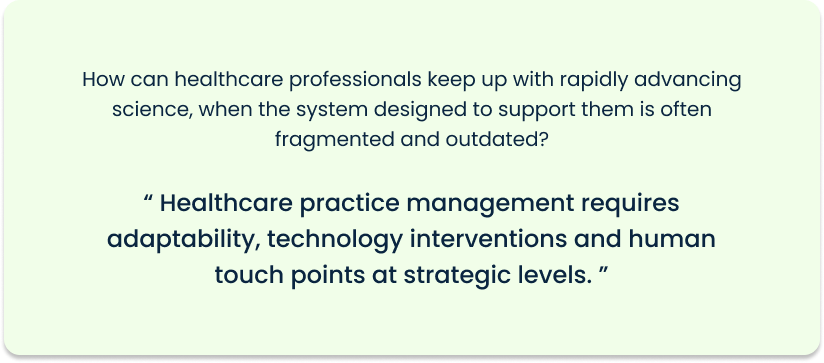
Need for Adaptable EHR Solutions in Value-based Care
As healthcare practice evolves, so do the demands on technology solutions, particularly Electronic Health Records (EHR). Traditional EHR systems often fall short when it comes to meeting the diverse needs of modern healthcare providers. This is where adaptable EHR solutions come into play, offering a more tailored and flexible approach.
The healthcare environment today is dynamic, with each specialty and care setting presenting unique requirements. Customization is crucial; an adaptable EHR can accommodate these varying needs, enhancing workflow efficiency and improving both patient and provider experiences. In fact, custom EHR solutions allow healthcare organizations to optimize their workflows, leading to more efficient and personalized care interventions.
Moreover, adaptable EHR systems are essential for integrating new technologies such as artificial intelligence and machine learning, which are increasingly used to improve clinical decision-making and patient engagement. This flexibility allows providers to evolve with the changing landscape of healthcare, ensuring they can deliver high-quality care while managing administrative burdens more effectively.
The right EHR system should not only support current needs but also be scalable to address future challenges, making adaptability a key feature for any modern healthcare solution. blueBriX, with its decade-long experience providing customized EHR solutions and other micro-services exclusively for healthcare, thus came up with blueEHR, a highly adaptable and scalable EHR solution for today and tomorrow. blueEHR excels in addressing the current challenges faced by healthcare providers, offering a fully integrated, cloud-based system that is customizable to meet the specific needs of different practices. Its scalability ensures that healthcare organizations can seamlessly adapt to evolving industry demands, whether it be integrating telemedicine, supporting care coordination, or addressing data security issues.
Let’s explore in detail, how blueEHR can be your value-based care organization’s go-to solution for success.
blueEHR Overview
blueEHR is a comprehensive cloud-based electronic health record (EHR) solution designed to optimize healthcare delivery and enhance patient care. It offers a scalable and customizable platform that allows healthcare organizations to tailor the system to their unique workflows and requirements, including appointment management, clinical note-taking, referral management, and utilizing a clinical decision rule engine.
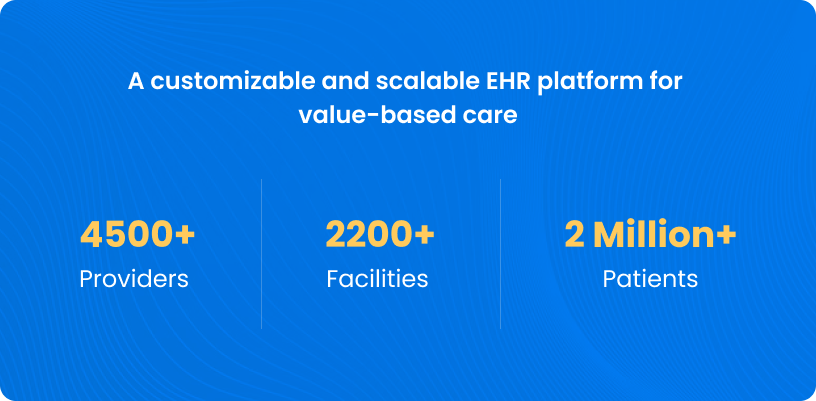
Why value-based care organizations need blueEHR?
blueEHR is pivotal in advancing value-based care by enhancing healthcare delivery and optimizing patient outcomes. Its customizability allows healthcare providers to tailor workflows to align with specific care models, supporting personalized patient engagement. Interoperability ensures seamless integration with external systems, enabling holistic patient management across different care settings. The platform’s powerful analytics and reporting tools facilitate data-driven insights that improve care quality and support proactive decision-making. Additionally, its robust security and compliance measures protect sensitive patient information, ensuring trust and adherence to regulatory standards. Together, these features help healthcare organizations transition to value-based care, where the focus is on quality outcomes and patient satisfaction rather than volume of services.
What sets blueEHR apart from the traditional EHR systems?
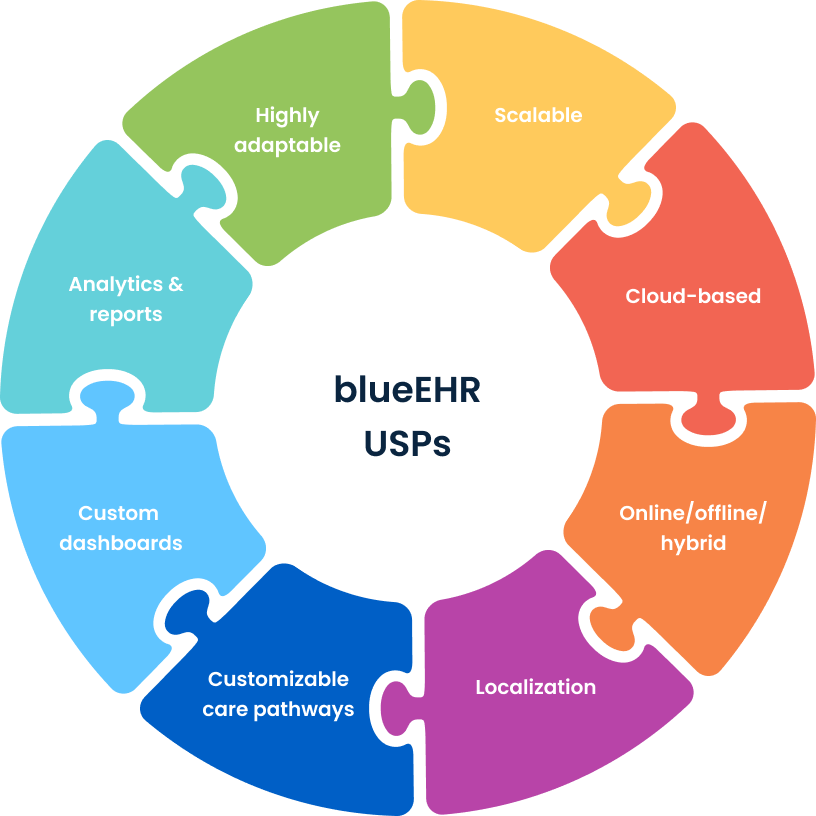
blueEHR stands out from traditional EHR systems due to its flexibility, scalability, and robust online/offline capabilities. Unlike rigid systems, blueEHR is a modular platform that can be fully customized to suit the unique workflows of various healthcare settings, enabling efficient growth and adaptation over time.
Additionally, blueEHR’s cloud-based infrastructure reduces the burden of managing on-site IT systems. It significantly lowers upfront infrastructure costs, as all system maintenance is handled by the vendor, offering healthcare providers financial flexibility.
One of the most distinguishing features of blueEHR is its ability to operate both online and offline, ensuring continuous access to patient data even in low-connectivity environments. This feature is essential for remote or underserved areas where internet access is unreliable. The hybrid model—where the system can function offline and sync with the cloud once reconnected—offers optimal flexibility and ensures that healthcare delivery remains uninterrupted. This online/offline hybrid feasibility makes blueEHR ideal for practices that require constant adaptability to both urban and remote settings, making it a future-ready solution.
blueEHR’s robust localization features come handy for cross-country, cross-culture organizations connecting teams worldwide. It supports 36 languages, ensuring that healthcare providers across the globe can use the system in their native language, which fosters ease of use and improves accuracy in data entry and patient interaction. This multilingual capability makes blueEHR an ideal solution for global healthcare organizations operating in diverse regions.
In addition, blueEHR enables providers to create custom care pathways, custom dashboards and reports, allowing providers to tailor the system to their unique workflows and patient needs. This flexibility ensures that providers can deliver personalized care that aligns with their specific practice requirements, further enhancing the efficiency and effectiveness of healthcare delivery.
Clinical Advantages of blueEHR: Empowering Value-based Care Providers
blueEHR provides numerous clinical advantages designed to optimize healthcare delivery and improve patient outcomes, especially in value-based care. One of its core strengths is its intuitive charting and customizable workflows, which allow providers to streamline clinical processes. With drag-and-drop technology, clinicians can easily tailor workflows to match the unique needs of their practice, ensuring efficient data entry and decision-making.
The system also integrates real-time data entry through features like voice recognition, enabling clinicians to upload patient information on the go, thus reducing administrative burdens and improving accuracy. Additionally, blueEHR supports telemedicine and remote care capabilities, which enhance patient engagement and ensure continuity of care across different settings, further contributing to improved patient satisfaction and clinical outcomes.
By supporting interoperability, blueEHR ensures seamless communication between various healthcare systems, enabling coordinated care and informed clinical decision-making, which is crucial for effective patient management.
Financial Benefits: How blueEHR Drives Cost Efficiency
blueEHR offers significant financial benefits that help healthcare organizations streamline operations while reducing costs. One of the key features is its Revenue Cycle Management (RCM) solution, which ensures faster claim recoveries, helping organizations recover more than 90% of claims in the shortest time. This accelerates cash flow and reduces the burden of delayed payments, enhancing financial efficiency.
In addition to RCM, blueEHR provides cost-effective implementation through its cloud-based platform, eliminating the need for expensive on-premise infrastructure. The system also supports modular customization, allowing healthcare providers to only pay for the features they need, thereby controlling operational costs.
By utilizing APIs for quick integration with existing systems, blueEHR further reduces implementation time and associated costs, making it an ideal solution for cost-conscious healthcare organizations. These financial advantages position blueEHR as a highly efficient choice for both small and large practices looking to optimize their expenditures.
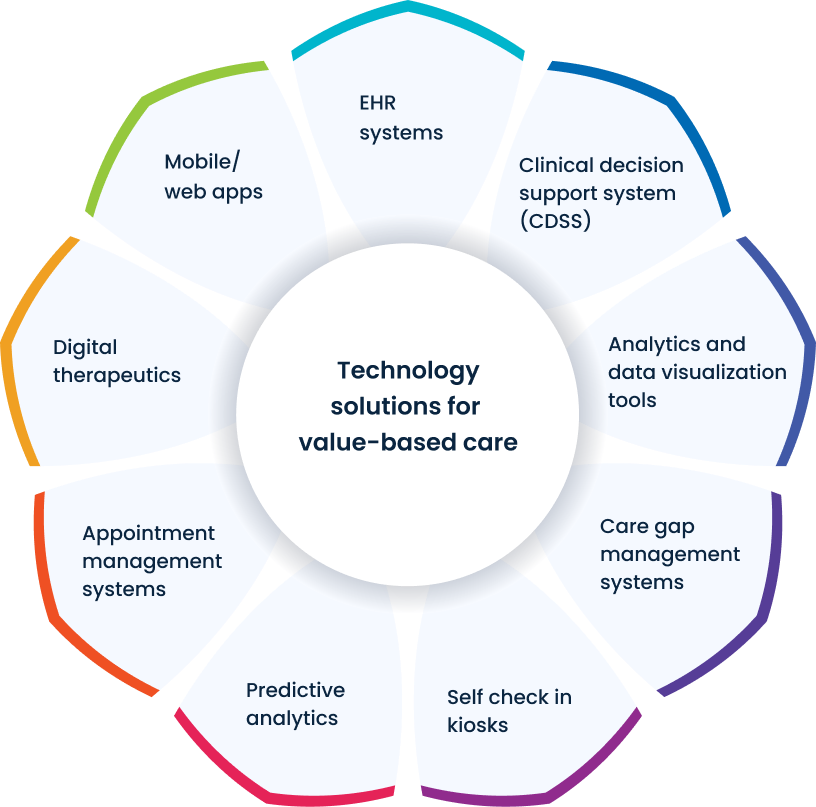
Core Functionalities of blueEHR
blueEHR is designed to streamline clinical operations while enhancing the quality of patient care through its comprehensive set of core functionalities. These features are crafted to optimize workflows, improve data accuracy, and facilitate better decision-making. By providing customizable modules and intuitive tools, blueEHR empowers healthcare organizations to deliver more effective care, ensuring that both clinical and administrative processes are seamlessly integrated.
The following section will take you through the core functionalities of blueEHR and explore how they directly contribute to improving clinical operations and enhancing patient outcomes:
Electronic Health Records (EHR)
blueEHR offers a comprehensive suite of functionalities within its EHR system, including clinical and patient reminders, a rule engine for task automation, customizable dashboards, scheduling, encounter review, prescription management, and robust security and compliance measures.
Practice Management
blueEHR has extensive practice management functionalities, such as a scheduling workbench, an office manager dashboard, a specimen collection dashboard, and customizable user settings and notifications, streamlining healthcare operations.
Revenue Cycle Management (RCM)
blueEHR’s RCM functionalities include customizable workflows, powerful analytics and reporting, seamless interoperability, and robust security and compliance measures, optimizing healthcare delivery and operational efficiency.
Patient Engagement Tools
blueEHR offers tools for online patient engagement through Internet-based learning management systems, allowing access to external educational materials to enhance patient involvement in their healthcare choices.
Telehealth Integration
blueEHR integrates telehealth functionalities, enabling video consultations directly from the calendar or encounter notes modules, ensuring convenient and secure specialized care.
Clinical and Patient Reminders
blueEHR facilitates the creation and configuration of reminders to enhance patient care and follow-up. This improves appointment adherence and reduces no-shows.
Amendments
Healthcare providers can refine patient information with precise edits and accurate records based on requests from patients or insurance providers using our amendments functionality.
Scheduling Workbench
This functionality lets clinics and hospitals can enroll patients, send forms, verify insurance, request authorizations, and schedule appointments with ease.
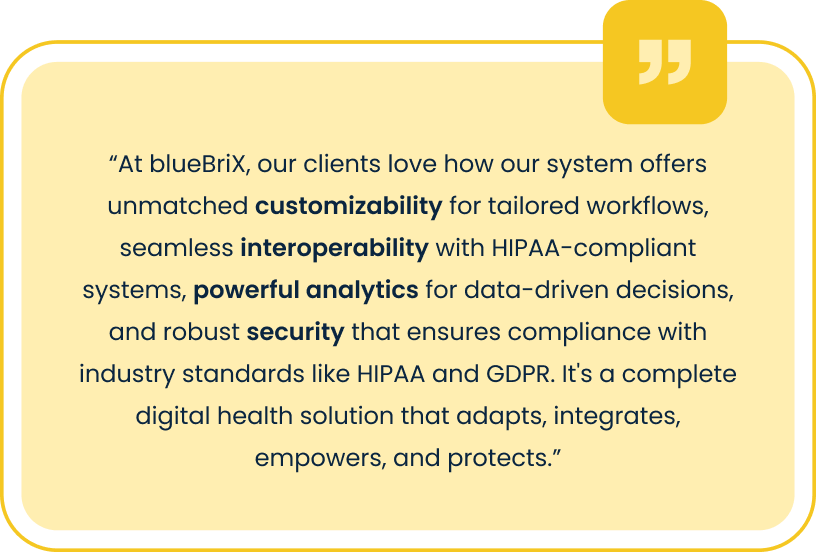
Did you know that blueEHR can be adapted to resolve your value-based care dilemmas? Learn more
Advanced Features of blueEHR
Customizable Forms and Reports
blueEHR allows users to customize forms and reports. Clinics can customize blueEHR to streamline its appointment management and clinical note-taking processes. For one of our clients, we have configured specific forms for patient intake and customized the clinical decision rule engine to match their clinic’s protocols. This helped reduce their administrative overhead significantly, allowing the provider to focus more on patient care.
Interoperability with External Systems
blueEHR ensures seamless interoperability with HIPAA-compliant systems, including HIEs, laboratories, billing systems, medical devices, and wearables, facilitating comprehensive patient care and data exchange. One of our larger clients integrates blueEHR with external laboratories and HIEs. This ensures that lab results and patient data are automatically updated in real-time, enhancing the accuracy and completeness of patient records. Consequently, they are able to make more informed decisions, improving overall patient outcomes.
Artificial Intelligence and Predictive Analytics
blueEHR incorporates advanced analytics and predictive analytics capabilities, enabling healthcare providers to analyze patient data, identify patterns, monitor outcomes, and make informed clinical decisions. One of our hospital clients utilize blueEHR’s analytics and reporting functionalities to improve clinical performance and patient outcomes. By extracting and analyzing patient information, the hospital identifies patterns and monitors key performance indicators. Integration with reporting systems like PowerBI and Tableau allows for advanced data visualizations, enabling data-driven improvements in patient care and operational efficiency.
Multilingual and Localization Support
blueEHR provides robust multilingual and localization support, allowing users to interact with the application in their preferred language and ensuring clear communication and personalized care.
Configurable Dashboards
Configurable dashboards within blueEHR offer a comprehensive view of clinical insights, financial trends, and patient care quality. These dashboards can be tailored to display key metrics, trends, and real-time data relevant to different roles within the healthcare facility. They provide visual representations such as graphs, charts, and tables that help in monitoring performance and making informed decisions. At a busy outpatient clinic, the configurable dashboards are utilized to manage patient care and operational efficiency. The clinic’s staff use the real-time clinical insights provided by the dashboards to track patient progress, identify trends in treatment outcomes, and make data-driven decisions. Financial trends, such as revenue and expense tracking, are also monitored to ensure the clinic remains financially healthy. By integrating these insights into daily operations, the clinic is able to handle a higher volume of patients while maintaining high standards of care and optimizing resource allocation.
Appointment Scheduling
blueEHR’s scheduling tools streamline the process of enrolling patients, sending necessary forms, verifying insurance, requesting authorizations, and scheduling appointments. These tools are designed to automate and integrate various scheduling tasks, reducing manual effort and minimizing errors. They also offer features like appointment reminders and confirmations to enhance patient engagement and reduce no-show rates. An outpatient clinic uses blueEHR’s scheduling tools to streamline patient enrollment and appointment management. The clinic can quickly enroll new patients, verify their insurance coverage, and request any necessary authorizations. Automated scheduling and reminders reduce patient wait times and administrative burdens. This efficient scheduling process enhances overall clinic efficiency, leading to a smoother workflow and improved patient satisfaction.
Encounter Management
Encounter management tools in blueEHR help track assigned encounter notes, ensuring that they are reviewed, edited, and signed off promptly. These tools facilitate the documentation of patient interactions and clinical notes, helping healthcare providers maintain accurate and up-to-date patient records. In a hospital setting, healthcare providers can use blueEHR to manage encounter notes effectively. Each provider can be assigned specific notes for review and sign-off. The system’s tracking capabilities ensure that no notes are overlooked and that all documentation is completed in a timely manner. This organized approach to encounter management supports accurate record-keeping and enhances the quality of patient care by ensuring all relevant information is captured and available for future reference.
Prescription Management
Prescription management features in blueEHR allow providers to view, manage, and track prescriptions, including checking estimates, payment statuses, and printing prescriptions. This functionality streamlines the medication management process, ensuring that prescriptions are handled efficiently and accurately. Providers can quickly access and review prescription details, check the status of payments, and print prescriptions as needed. This streamlined process reduces administrative overhead and minimizes the risk of errors, leading to a more efficient medication management workflow and improved patient care.
Office Manager Dashboard
The office manager dashboard within blueEHR allows office managers to track providers’ daily appointment schedules and monitor the status of intake forms. This dashboard provides a centralized view of clinic operations, enabling office managers to oversee scheduling, manage patient flow, and ensure that all necessary documentation is completed. In a healthcare facility, the office manager can use blueEHR’s dashboard to efficiently manage daily operations. By tracking appointment schedules, the manager can ensure that providers are on track and that patient appointments are handled smoothly. Monitoring the status of intake forms helps to prevent delays and ensures that all required paperwork is completed before patient visits, contributing to a well-organized and efficient clinic environment.
Specimen Collection
The specimen collection module in blueEHR facilitates the management of lab orders, tracking of specimens, and input of test results. These tools ensure that lab orders are processed efficiently, specimens are located and tracked accurately, and results are communicated promptly to healthcare providers. A laboratory leverages blueEHR’s specimen collection dashboard to streamline lab operations. The dashboard helps manage incoming lab orders, track the location of specimens throughout the testing process, and input test results into the system. This efficient handling of specimens reduces the likelihood of errors, ensures timely reporting of results, and improves communication between the laboratory and healthcare providers.
System Configuration
System configuration features in blueEHR include custom form building with a drag-and-drop interface, management of medical codes, and detailed audit logs. These tools allow healthcare facilities to tailor the system to their specific needs, ensuring accurate data capture and streamlined workflows. One of our clients, a healthcare facility, customizes blueEHR forms using the drag-and-drop interface to better match their specific operational requirements. This customization ensures that forms are tailored to capture the exact data needed for their processes. Managing medical codes and maintaining detailed audit logs further supports compliance and accurate record-keeping, helping the facility maintain efficient and reliable operations.
Patient and Contact Management
blueEHR’s patient and contact management tools allow users to organize, update, and access vital contact details and patient information efficiently. This feature supports accurate data management and ensures that all relevant information is easily accessible. This efficient management of patient data facilitates better communication with patients and between healthcare providers, supporting improved care coordination and administrative efficiency.
Menu Navigation
The menu navigation feature in blueEHR provides easy access to various modules such as Calendar, Analytics, Claims Manager, and more. Users can mark frequently used modules as favorites for quick access, enhancing productivity and ease of use. By marking frequently used modules as favorites, providers can quickly navigate to the tools they need, saving time and improving workflow efficiency. This streamlined navigation supports better productivity and allows providers to focus more on patient care.
Search and Add Patients
blueEHR offers quick and advanced search options to efficiently locate patient records, as well as simple processes for adding new patient records. These features improve administrative efficiency by making it easier to manage patient information. The efficient search capabilities reduce the time spent searching for patient information, while the streamlined process for adding new records ensures that patient information is entered accurately and promptly. This improves overall administrative efficiency and supports better patient management.
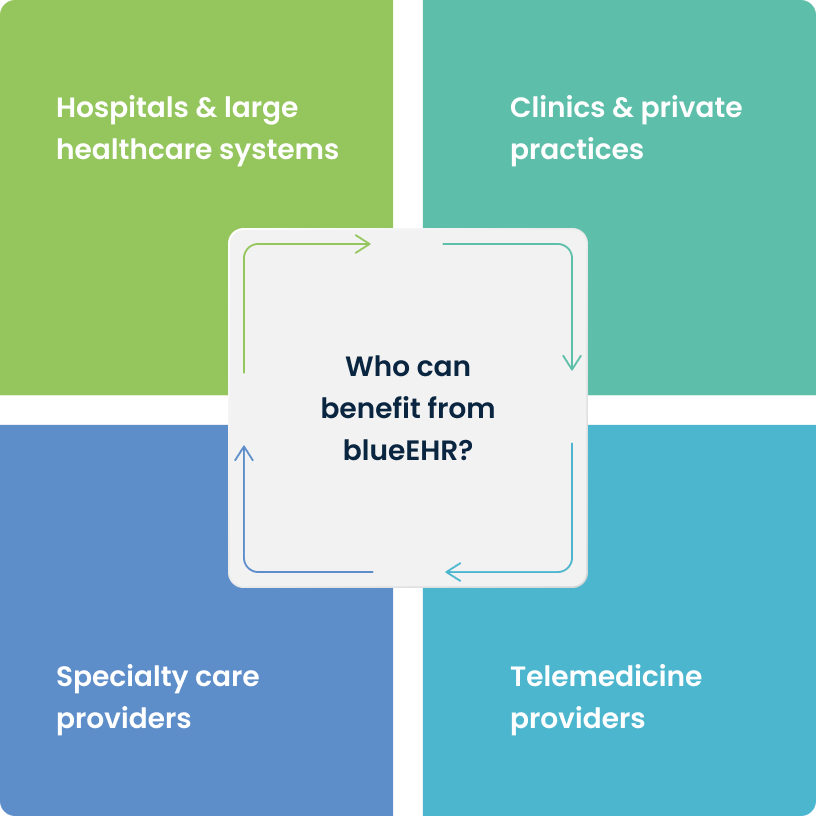
Scalability and Customization
The ability to scale and customize EHR systems is critical in a rapidly evolving healthcare landscape. Scalability and customizability are key features of an EHR system that support growth and flexibility. Scalability ensures the system can handle increased data, users, and demand as a healthcare organization grows, maintaining performance without disruption. Meanwhile, customizability allows the system to be tailored to specific workflows, specialties, and regulatory needs, ensuring it aligns perfectly with the organization’s unique practices. Together, these features enable healthcare providers to expand seamlessly while delivering personalized, efficient care. blueEHR, our integrated electronic health records management system, is designed with scalability and customization at its core, providing healthcare providers with a flexible, adaptable solution that grows with their needs. Together, these features empower healthcare organizations to optimize their operations, stay compliant, and deliver personalized care, no matter how their needs change over time.
Scalability for Organizations of All Sizes
Scalability ensures that blueEHR can efficiently handle increasing volumes of patient data and expanding clinical operations, whether for a small clinic or a large hospital network. This adaptability allows healthcare organizations to scale up or down seamlessly, avoiding disruptions in service delivery as they evolve. blueEHR is designed with robust scalability, utilizing vertical and horizontal scaling, multi-availability zones, elastic load balancers, and other AWS tools to handle varying loads efficiently.
Customizable Workflow and Interfaces
Customization offers the freedom to tailor the system to specific workflows, specialties, and regulatory requirements. By providing tools to modify templates, forms, and interfaces, blueEHR offers a highly customizable workflow and interface, allowing organizations to tailor elements to match specific workflows and improve efficiency in healthcare delivery.
Tailor-Made Solutions for Unique Healthcare Needs
blueEHR provides tailor-made solutions, with over one million hours invested in enhancing usability and functionality, ensuring it meets diverse client needs regardless of size or specialty.
Check out how blueBriX empowered Vivos Therapeutics’ rapid growth with scalable tailor-made digital health solutions
Integrations and Compatibility
Having realized that a flexible and interoperable EHR system is crucial to navigate the evolving healthcare landscape, we made sure that blueEHR addresses this need with a robust suite of integration and compatibility features to seamlessly connect with various healthcare tools, applications, and third-party systems. This capability ensures that healthcare providers can maintain a comprehensive, cohesive view of patient data, streamline workflows, and enhance overall efficiency.
By enabling smooth data exchange and interoperability, blueEHR allows healthcare organizations to connect disparate systems such as laboratory information systems, billing software, wearable devices, and patient engagement platforms. Its compatibility with both legacy systems and modern digital health solutions provides a versatile, scalable framework that supports diverse healthcare environments—from small clinics to large hospital networks.
Integration with Wearable Devices and IoT
blueEHR allows integration with wearable devices and IoT systems, enabling patients to upload vital information directly into the EMR, enhancing the comprehensiveness of medical records.
Compatibility with Third-Party Applications and APIs
blueEHR supports integration with third-party applications and APIs, ensuring seamless data exchange and enhanced overall functionality.
Seamless Data Migration and Management
blueEHR provides a dedicated Migration module for efficient data transfer from legacy systems, ensuring accuracy and completeness of historical information.
Security and Compliance
Compliance
blueEHR prioritizes security and compliance to ensure patient data remains confidential and secure across multiple regulatory frameworks. In addition to being HIPAA-compliant, blueEHR is fully compliant with GDPR standards, safeguarding patient data and privacy for organizations operating within the European Union. The platform also carries CE Marking, demonstrating adherence to stringent EU safety and performance requirements for medical devices. Moreover, blueEHR is ONC Certified HIT, meeting the 2015 Edition Meaningful Use criteria, ensuring that healthcare providers can leverage advanced health IT capabilities while maintaining regulatory compliance across jurisdictions. This includes the use of advanced encryption techniques, role-based access, and robust audit trails to protect data at rest and in transit from unauthorized access.
Data Privacy & Security
In addition to encryption, blueEHR employs role-based access controls to limit data access to authorized personnel only. Healthcare providers can customize these roles to align with their organization’s structure, ensuring that staff members only have access to the data they need. This is further supported by secure authentication protocols, including multi-factor authentication (MFA), which enhances security by requiring multiple forms of verification before granting access to the system.
These features not only comply with regulatory standards like HIPAA, but also provide healthcare organizations with peace of mind knowing that their patient data is protected from potential breaches or unauthorized access.
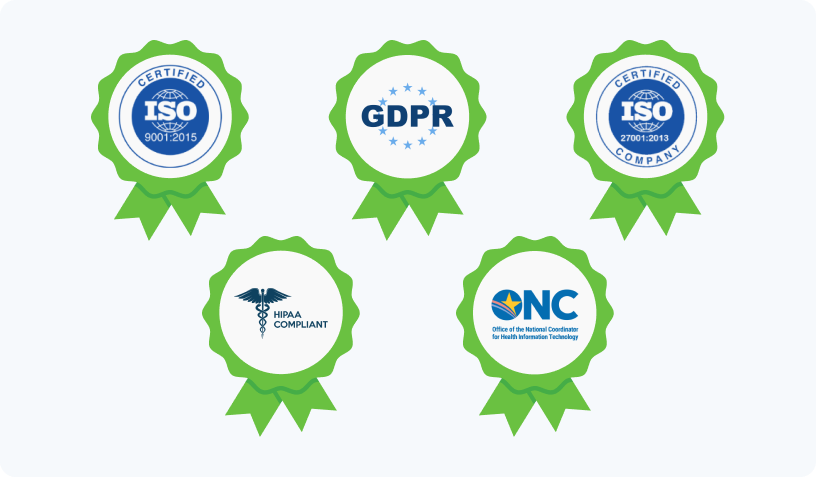
Improving Patient Outcomes and Engagement
Utilizing patient portals for enhanced communication
Patient portals are essential tools for improving patient engagement and outcomes in value-based care. With blueEHR, patient portals serve as centralized hubs where patients can securely access their health records, view lab results, schedule appointments, and communicate with their providers in real time. This transparency fosters trust and keeps patients actively involved in their care journey, ultimately improving clinical outcomes.
Integrating telemedicine for better care accessibility
blueEHR’s telemedicine features ensure that patients can access care regardless of location, providing a seamless way for providers to monitor chronic conditions like diabetes or conduct virtual consultations. By integrating telemedicine, blueEHR helps reduce care gaps, improves accessibility, and delivers enhanced patient satisfaction in remote or underserved areas.
Encouraging patient adherence through automated reminders and educational resources
blueEHR goes beyond basic communication by incorporating automated reminders and educational resources, helping patients adhere to medication schedules and follow-up appointments. This proactive engagement through reminders improves adherence rates, reduces complications, and empowers patients with the knowledge they need for better self-management.
With its customizable features and integrative capabilities, blueEHR not only optimizes patient-provider communication but also delivers a comprehensive solution that ensures consistent engagement and better healthcare outcomes which contribute to value-based care success.

User Experience and Accessibility
User Experience (UX) and Accessibility are critical in digital health because they directly impact patient engagement, adherence, and outcomes.
A well-designed user experience ensures that digital health tools are intuitive, easy to navigate, and reduce cognitive load, making it simpler for patients and healthcare providers to access information and perform necessary tasks efficiently. Accessibility is equally vital, as it ensures these tools are usable by all individuals, regardless of their physical abilities, language proficiency, or digital literacy. When digital health platforms prioritize UX and accessibility, they enhance trust, foster patient empowerment, and contribute to more equitable healthcare delivery, ultimately leading to better health outcomes and higher satisfaction rates.
User-Friendly Interface Design
blueEHR offers a user-friendly interface with customizable home pages, dashboards, and easy navigation, improving productivity and patient care quality.
Multi-Platform Accessibility (Web, Mobile)
blueEHR provides multi-platform accessibility, allowing users to manage patient records and tasks from any device, offering flexibility and convenience.
Training and Support Resources
blueEHR offers comprehensive training and support resources, including user guides, live chat support, and detailed documentation, ensuring effective system utilization.
Ready to elevate your healthcare delivery to the next level? Choose blueEHR to empower your organization with a scalable, customizable, and secure digital health platform. Don’t just adapt to the future of healthcare—lead it. Connect with us today to see how blueEHR can transform your approach to patient care and help you achieve better outcomes, greater efficiency, and true value-based care.

